Due to various circumstances, electric heating of a private house or apartment is increasingly being considered by homeowners as one of the options for heating a home. In terms of the cost of buying equipment and installing it, this is the cheapest way, but high tariffs make many people abandon this idea. However, it is possible to heat a house with electricity, and in this article you will find tips on how to implement it in the best way.
Electric heating in the apartment
I must say that electric heating, made by oneself or with the help of a specialized organization, is the most comfortable, reliable and environmentally friendly way to heat rooms. It does not require maintenance, is easy to regulate and automate, and does not create harmful emissions.
If it were not for the price of the energy carrier, it would be difficult to choose the best option. But for apartment owners, there is a second problem - a limited consumption limit (usually 3-5 kW).
Advice. You need to think about the power consumption limit in advance, as soon as you decide to organize electric heating apartments. It is necessary to carefully read the contract with the supplier, which indicates this limit, and may also contain clauses prohibiting the use of electricity to heat housing.
At present, there are various electrical systems heating that can be used in the apartment. Consider them in ascending order of cost:
- convectors and fan heaters;
- infrared space heating;
- plinth electric heaters;
- film and cable underfloor heating;
- traditional water system with radiators and electric boiler.
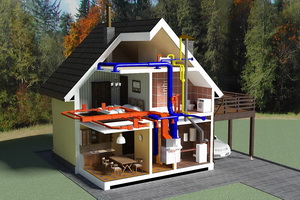
Wall-mounted electric convectors are installed in places where water heating radiators should also be located - under windows and near cold walls. Fan heaters, as a rule, have a portable design and forced air injection. You can put them in the most convenient places. This is the cheapest and least efficient electric heating of an apartment.
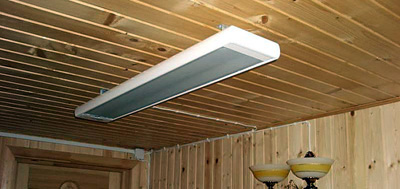
Heating with infrared radiation devices will be more efficient. These devices, attached to the ceiling, heat all surfaces, and the air is already warming up from them. Also a good option is skirting convective heaters, located around the perimeter of the room. But these devices must be mounted instead of skirting boards, and these are additional costs.
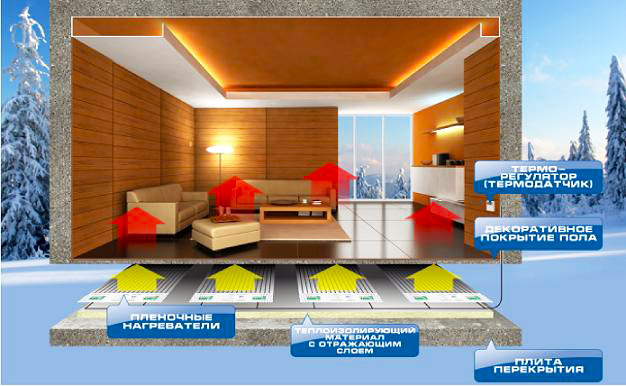
A very popular and proven method is electric heating of rooms. warm floors. Heating cable, electric cable mats or heating foil are used for this purpose. The cost of the elements is relatively low, but installation under a screed or coating will cost a pretty penny. Floor heating is the most economical, it gives a feeling of comfort and pleasant warmth.
The above methods have the disadvantage that they can only function with the help of electricity. In the event of a change in the tariff towards a rise in price, supply to the house natural gas or other circumstances, it will be necessary to change the energy carrier, and then the installed systems and purchased equipment will be useless. To avoid this, it is necessary to install an electric boiler for heating the apartment and do the usual water system with radiators. Then, to change the energy carrier, you only need to purchase a new heat source.

If the area of the apartment is small, then the best option is cable underfloor heating, they are unmatched in terms of comfort. Cheap methods also have the right to life, but in extreme cold these funds may not be enough and the rooms will become cool.

In a large apartment, it would be more appropriate to arrange radiator independent electric heating or water heated floors.

Advice. If there are old cast-iron batteries in the apartment, they can be used as autonomous water heaters by building a low-power heating element into each of them. The heating elements are connected to the network through thermostats, as shown in the video:
Electric heating of a private house
To organize electric heating of a private house is to some extent easier than in an apartment. The power consumption limit is much higher, it is possible to control and put in order all the wiring, starting from the power line. From the list above, a water heating system with an electric boiler is most suitable for a cottage. The reason is simple: it is necessary to ensure the use of different energy carriers, and not just electricity. This means that you need to select a boiler, install it and mount a one- or two-pipe system.
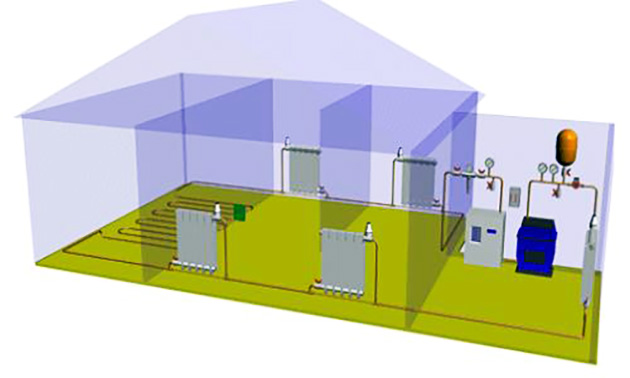
Advice. In order to quickly switch to another type of fuel in an emergency, the electric heating scheme of a private house should include alternative source heat. If both boilers are correctly connected to each other, then the transition will occur automatically. The connection is made according to the scheme:
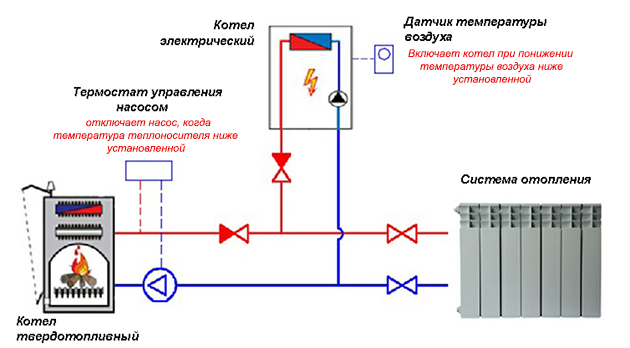
At the moment, the market offers 3 types of household heat sources, which are used to arrange electric heating at home:
- heating elements;
- electrode;
- induction.

Without exaggeration, we can say that heating elements are considered the most common, affordable and easy to install. Externally, the unit is similar to a wall-mounted gas boiler. Inside, in addition to the actual heaters, there is a circulation pump, expansion tank and a complete set of automation. A heat generator of this type is shown above in the piping diagram.

Electrode boilers are cheaper than heating elements, but not so well equipped. The circulation pump and expansion tank will have to be bought separately and mounted by hand. So the installation of the unit as a whole will be more expensive.

Plus, it is necessary to withstand the chemical composition of the coolant so that it contains the amount of salts necessary for the electrode heating process. And one more important point: the electrode boiler cannot work at half strength, but only at full capacity.

Temperature control takes place in on / off mode. Purchase and installation in private house induction heat generator will require the highest costs. In terms of piping, it is similar to the electrode boiler, since it only has a control cabinet with automation in the kit. The unit itself is reliable and durable, but has a high price.
Important. Connection of any electric boiler must be carried out with its grounding in accordance with safety rules.
How to save electricity?
To make economical electric heating in a private house, you must adhere to the following recommendations:
- use multi-tariff electricity metering, the night tariff is much lower than the day one;
- during business hours, try to heat the house with non-electric heat sources;
- install thermostats in the rooms;
- make a choice towards underfloor heating systems;
- traditional advice: insulate your house or the outer wall of the apartment as much as possible.
Do not give up on automation tools that will help reduce the temperature in unused rooms and, in general, do not shun any means to reduce energy costs. Approach the issue systematically.
Conclusion
Most of the inexpensive electric heating intended for local heating different rooms - in the house, garage, in the country and so on. They cannot be taken as the main way to heat a home, since during severe cold weather a fan heater or an infrared heater may not be enough. When making electric heating in a house or apartment, remember the reliability of the wiring; for powerful heating devices, it is always better to lay a new one.
When choosing a heating system for their own home, the owners, of course, first of all consider the possibility of installing a gas boiler, since this type of heating is by far the most economical. But here's the problem - gas supply lines are still far from reaching all settlements, or it happens that gas wiring to the house is unaffordable in terms of financial capabilities and due to the mass of preparatory and conciliatory procedures. Heating on solid or liquid fuels is not always convenient - it requires special skills in handling stoves or boilers, compliance with increased requirements fire safety, constructions according to all the rules of the chimney system in order to exclude poisoning by combustion products. And besides, in some regions of our country, which are not rich in forests, the supply of firewood or coal can be a problem.
In this case, the most relevant is the electric heating of a private house. Surely, many immediately associate with oil-filled electric radiators or reflectors, which are neither particularly efficient nor economical. Of course, with this approach, at current electricity prices, heating will cost a lot of money. However, not everything is so clear. There are many ways to use electricity to heat your home, and some of them may well compete with gas systems.
The publication will consider the existing possibilities for organizing electric heating of a private house. Read, draw conclusions so that you can make a decision in favor of one or another option.
Just a few words about those electric heaters that are known to everyone, probably from childhood:
- Heating reflectors, usually with one or more spirals, placed in transparent quartz glass tubes. Such devices create a directed flow of thermal energy, but are only capable of heating either very small rooms, or a very limited area of \u200b\u200bthe room. At the same time, it is impossible to call them economical - usually they do not provide for any automatic adjustments, except for changing the set heating level of the spiral.
Fan heater - not even considered as heating
- Thermal fans - drive the air flow through the heat exchanger (most often an open nichrome spiral acts as this). The heated air flow can only increase comfort in a certain area and for a very short time. Something that can be very good for a small office, in a residential country house will give no effect. In addition, prolonged operation of such a device burns quite strongly, dries the air in a closed room. Some modern models they work on the principle of mixing air from outside, but all the same, it is impossible to consider such devices as home heating.
Oil cooler - good only for additional local heating
- Oil radiators are heavy heaters with a pronounced ribbed shape, similar to classic cast iron radiators. They can be mobile (many even have wheels to make them easier to move around the room), or permanently installed.
Such radiators are able to heat up to very high temperatures and give off energy in the form of direct thermal radiation and the creation of convection currents. Their ribbed shape significantly increases the area of active heat exchange.
Oil radiators usually have step or smooth adjustment of the heating medium heating temperature, have good thermal inertia - even after turning off they are able to stay warm for quite a long time. However, their efficiency is low, and such devices are usually used as additional heating, to help the main one, when the need arises. It will simply be unprofitable to build the entire heating system based on oil coolers.
Water heating system with electric boiler
The organization is described in great detail in the corresponding publication of our portal.
The main feature of such a system under the conditions considered in this article is that the liquid coolant receives heating only from an electric boiler. This determines several parameters characteristic of it:
- Such a system should be designed exclusively for forced circulation. The reason is simple - the device of the circuit under natural circulation will lead to significant losses of power, heat exchange rate, uneven heating of the premises, and in the end - all this will necessarily affect the unnecessary consumption of expensive electricity. The consumption of the pump cannot be compared with these losses.
- For the same reason, to avoid absolutely unnecessary losses, systems with electric boilers are never made according to the open type, that is, an expansion membrane tank with the appropriate security group.
Now - more about the types of heating electric boilers.
Boilers with heating elements
These installations use the usual principle of resistive heating of a metal conductor during the passage electric current(a direct analogy with electric stoves, irons, incandescent bulbs, etc.) however, given that the heating elements are in contact with a liquid coolant, they are dressed in reliable insulation and a waterproof housing. All this, of course, affects rather large energy losses, insufficiently high efficiency of such devices (usually around 80%). To ensure proper heating of a constantly circulating coolant, it is necessary either to sharply increase the power of the heating element, or increase their number, which reduces the overall efficiency of the heating system.
The layout of the boilers is different - from the usual rectangular shapes with controls on the front panel to cylinders with “bundles” of heating elements located inside and with a control unit placed in a separate box.
Designers are constantly improving their products, equipping them with automation that maintains the required level of heating, turns on the heating elements in stages as needed, and turns off the power when the required temperature is reached. But still, such boilers are among the most uneconomical, and their installation as the main heat generator will not be justified even by the low price of such devices.
Boilers of the electrode principle of operation
Of all the electric boilers, these are probably the most controversial. At one time, they were presented as practically no alternative in terms of performance and economy. However, a flood of critical remarks on their work soon followed.
The way they work is completely different. The coolant is not simple water, but brought to the state of an electrolyte - a conductive liquid. Frequency oscillations of the variable network (50 Hz) cause corresponding oscillations of the electrolyte ions, which gives it a quick heating.
The advantages of such boilers are as follows:
- They are small in size and do not differ in large mass, with a sufficiently high heating power.
This allows, for example, to combine their use by installing a kind of "batteries" from several small boilers, which can be included in the system as needed.
- Such boilers are completely insensitive to mains voltage surges within fairly large limits (± 15 ÷ 20% ). For their operation, the stability of the frequency of the alternating current is more important.
- They have fast heating and good efficiency (according to the manufacturer - 20% more economical than heating elements), while their cost is low. The declared efficiency of such a device is up to 98%.
- If the boiler is tied with metal pipes, then this expands the ionization zone of the coolant and gives a tangible increase in system performance.
- From the point of view of fire safety - such a boiler, in principle, cannot overheat, if suddenly there is no coolant in the pipes - it simply will not turn on.
However, a lot of criticism can be heard against such boilers:
- There are special requirements for purity and certain chemical composition coolant electrolyte. In case of non-compliance with such requirements, all the advantages of the boiler are simply lost.
- Power instability is one of the characteristic features T t of such equipment. The intensity of heating is very dependent on both the chemical composition and the temperature of the electrolyte, since when it changes in any direction, the electrical conductivity also changes.
- Such a system is very difficult to adjust and automate the heating process.
- Regular cleaning of the entire heating system is required, as it will tend to salt overgrowing of pipe cavities.
- At least once a year, it is required to clean the heat exchanger of the boiler itself and to correct the chemical composition of the coolant.
- Installation and operation of such equipment is impossible if the electrical network of the house is not equipped with a reliable grounding circuit.
Boilers of the inductive principle of operation
These boilers are often considered the most advanced of all electric boilers. The principle of their operation is strikingly different from those described above. To understand it, you can remember the school physics course, and specifically, the operation of an electrical transformer.
If you do not go into details, then briefly it looks like this. If an alternating electric current passes through one conductor (primary winding), then a voltage is induced in the other, located in the resulting electromagnetic field (secondary winding). When the circuit of the secondary winding is closed, an alternating current also begins to flow through it, which causes resistive heating of the conductor.
- It is this principle that is applied in induction boilers of the SAV type.
The primary winding coil is hermetically placed in the housing, which does not come into contact with the liquid anywhere. But the role of a secondary closed winding is an internal labyrinth system of pipes through which the coolant is pumped. Heating occurs very quickly and evenly, there is no energy loss, so the efficiency of such boilers approaches 100%.
The efficiency of the boiler is also increased by the physical principle of self-induction - currents passing through a closed secondary circuit generate so-called reactive additional power, and its values \u200b\u200bare very significant.
Typically, boilers of this type are massive metal cylinders of various diameters and heights. So, the smallest boiler in this “line” is SAV -2.5, has a diameter of 120 mm, a height of 450, and at the same time weighs 23 kg. Its power (2.5 kW) will be enough to heat a room up to 30 m².
Installation of such a device is not difficult, as there are threaded pipes for inserting it into the system, a control unit for connecting to the mains.
- Induction tols are arranged and work somewhat differently. VIH(vortex induction heaters).
The mains supply voltage undergoes preliminary conversion to high-frequency, which gives a rapid increase in the strength of the electromagnetic field and, accordingly, the strength of the currents it generates. But there is no secondary winding in this circuit - its role is played by all the metal surfaces of the boiler, which are made of alloys that have pronounced ferromagnetic properties. Induced surface eddy Foucault currents cause the effect magnetization reversal, which is always accompanied by almost instantaneous and very strong heating of ferromagnetic materials. It turns out that almost all massive parts of the device are involved in heat transfer, which determines its highest efficiency (efficiency - 99%).
Boilers VIH quite heavy: the smallest of them, with a power of 3 kW, weighs 30 kg with relatively small dimensions - a cylinder diameter of 122 mm and a height of 620 mm. Such a "baby" will cope with heating 40 m². If desired, you can purchase a more powerful device (the product line is quite wide) or install a “battery” of several VIN boilers, which will provide additional benefits when operating the heating system.
"Battery" of six boilers VIN
Summing up the boilers of the induction principle of operation - briefly about their main advantages:
- In such heaters, there is no formation of scale or salt deposits - the work is accompanied by high-frequency microvibrations, which do not allow precipitation to settle on the walls. The efficiency of the device in the course of even a very long operation does not decrease.
- Any liquid can be used as a heat carrier - there are no special requirements for its chemical composition.
- There are practically no vulnerable nodes in the design of the boilers - there is no contact between the coolant and the electrical part. There is simply nothing to break in them and their service life is limited only by the state of the welds, and this is tens of years.
- Warming up is very fast, and electronic control units make it easy to fine-tune the heating system. However, induction boilers- the most "favorable" in terms of fire and electrical safety.
- Both calculations and the results of practical application show energy savings using such boilers up to 35 ÷ 40%, when compared with cats of similar power, operating on a different principle (electrode or heating elements).
Among the shortcomings, the following can be noted:
- Some owners complain about a slight vibration noise during their work.
- The boilers are very heavy and require special attention when mounted on walls.
- The equipment is quite expensive - even the most low-power induction boilers cost about 30 thousand rubles. However, this should quickly pay off by saving electricity.
To finish the topic with a water cooling system from an electric boiler - one more important note. Whatever unit is standing, it will be possible to talk about profitability only if the house has good thermal insulation and modern heating radiators with their own thermostats are installed. Old cast-iron batteries in this situation will simply ruin the owner.
Video: how to choose the right electric heating boiler
Electric convectors
The organization of a water heating system is always a large-scale work on laying pipelines, inserting batteries, installing circulation pumps, special safety devices and much more. Is it possible to do without all this if you plan to heat the house using electricity? Yes, installation of electric convectors will help to avoid such problems.
Outwardly, these devices most often resemble familiar heating radiators - they are installed vertically on walls or under window openings. Closed heating elements are located inside, which do not cause the effect of "drying out" of the air. The layout of the device is designed in such a way that cold air penetrates into it from below through the slatted bottom, receives heat from the heating elements and, leaving through the upper grate, creates a stable convection upward flow.
Convectors are always equipped with built-in thermostats that monitor the temperature in the room and turn off the heating when the values set by the users are reached. This ensures a sufficiently high efficiency of such a heating system.
The use of convectors provides a number of advantages:
- There is no need to install complex piping, with all its risks of leakage, freezing, etc. The owner of the house can handle the installation of such a heating system quite independently.
- There is no need to equip a separate room for the boiler room.
- Converters can be installed in any room in the required quantity (the main thing is that a reliable power line of the appropriate power is installed).
- Special models are produced for wet rooms - they can be installed in bathrooms or home saunas (protection class - IP -24). For ordinary residential premises, class IP-21 convectors are suitable.
- The devices are extremely easy to operate - you just need to set the required temperature on the scale or display panel. Everything else will be taken care of by automation. If necessary, you can turn off the heating in certain rooms if they are not currently in use.
- The safety of the devices is also their hallmark. They never have any exposed heating elements, and the heating in the outer panel is negligible and it is impossible to get burned on it, which is especially important if children live in the house.
- A variety of models and their design should satisfy the most demanding taste of the owners. Such convectors fit perfectly into any interior, sometimes even adding special details to it.
- The operation of convectors is absolutely silent.
Convectors can be made in a portable or mobile version, that is, it is possible, if necessary, to create temporary zones of increased comfort.
There are other original solutions. One of them is the installation of special convectors in the thickness of the floor, for example, in front of doors or wide windows. The heated air rises through a special decorative grille and creates an effective thermal curtain from the penetration of external cold.
Convectors may have a mechanical thermostat, but some modern models are equipped with an electronics unit that allows you to program the operation of the device. So, you can set for a certain time low temperature heating - when everyone is absent from the house, but with the expectation that by the arrival of the owners the convector will reach the required power and a comfortable atmosphere will be created in the premises.
Of course, such heating will become effective only with very high-quality thermal insulation of the house, otherwise expensive energy will be wasted. However, this is rather a problem of the building itself, and no no abundance of convectors.
Video: device and installation of an electric heating convector
Electric "warm floors"
Another way to organize the heating system of a private house from electricity is to install "warm floors". They produce several varieties of such systems.
- Heating cables - they are most often mounted in the thickness of the screed, which at the same time becomes a powerful accumulator of thermal energy. Cables can also vary - be single-core or two-core, work according to the usual resistive principle (heating of the conductor when passing electric current), or have a semiconductor matrix and have in connection with this effect of self-regulation of heating in each individual area.
- Heating mats are more convenient during installation. This is also a heating cable, but only reinforced on a fiberglass mesh base. The advantage of such mats is that they may not require a screed - for example, ceramic tiles can be laid directly on them, slightly increasing the thickness of the adhesive layer.
- Another type of heating electric mats is rod. Two conductors connected in parallel jumper rods having a special structure and working on the principle of self-regulation of heating. The convenience of this type is that the failure of any of their elements does not lead to the inoperability of the entire system as a whole. On such mats it is also possible to immediately lay ceramic tiles. As a disadvantage, it can be noted that the very high price of such heaters is still very high.
Regardless of the design, all electric "warm floors" are equipped with a temperature sensor, which is installed in the thickness of the floor, and a thermostat blog. Heating is carried out to a certain temperature, which is set by the owner of the house, and in the future the power will be turned on and off automatically to maintain this mode.
"Warm floors" are able to create a comfortable environment in the room with uniform heating of the entire volume of the room from the floor surface. However, this approach is not particularly economical, and can hardly be considered a complete alternative to other heating systems. Most often they are used in addition to the main sources of heat, to create zones of increased comfort.
Infrared heating systems
A modern solution to the problem of electric heating of a private house will be infrared heaters.
Such instruments and devices use the principle of wave energy transfer over a distance - you can draw a simplified analogy with sunlight. Specially selected emitter materials make it possible to convert electrical energy into radiation, in the long-wave infrared range, invisible to human sight. The emitters themselves heat up slightly, and infrared waves do not meet air resistance, but, falling on an opaque surface, they are converted into thermal energy. Thus, it is not the air in the room that is heated, but all surfaces and objects that are in the path of the rays. But these surfaces already, in turn, conduct heat exchange with the surrounding air. There is uniform heating, which starts very quickly after turning on the power. This ensures optimal temperature distribution, in contrast to convective systems.
Significant energy losses do not occur, which gives a high efficiency of such systems and their high efficiency.
Such heaters can be made in a suspended ceiling version, very reminiscent of conventional fluorescent lamps. They are placed above the places where the most intensive heating is required. They can also be portable, allowing you to direct the flow of energy into necessary time in necessary film radiant electric heaters. They are produced in the form of durable film strips of various widths and lengths. The emitters themselves (usually a special carbon paste or bimetallic foil plates) are placed between the layers of transparent heat-resistant plastic, connected by conductive copper bars.
The thickness of the film is very small - no more than 0.4 mm. It is very easy to install in the right place - on ceilings, walls, attic roof slopes, etc., and, if the owners wish, can be covered with finishing materials that will not significantly reduce the efficiency of the room heating system.
The film is heated to a temperature not exceeding 45 ÷ 50 ºС, and cannot cause burns or lead to a fire hazard. It is great for underfloor heating systems without using a screed - it can be placed under laminate, linoleum, parquet. Ingoda, simplifying their task, some owners simply cover such films with carpeting - for example, you can very quickly equip a particularly warm area for children's games.
PLEN is not afraid of dynamic loads, moisture ingress. Such heaters are easy to dismantle and move to another place - the main thing is not to damage the integrity of the film coating. Energy costs for such electric heating are considered the lowest of all existing types. Such a system is especially convenient for houses where the owners come periodically, for example, for the weekend - you just turn on the power, and intensive heating of the necessary premises or areas immediately begins. In addition, many medical experts assure of the special usefulness of such heaters, as they ionize the air to the extent necessary for human health and even eliminate unpleasant odors.
Video: advantages of the PLEN heating system
So, the main possibilities for organizing electric heating of a private house were considered. This type of heating has many advantages - absolute environmental friendliness, simplicity and accuracy in management, no need to create fuel reserves. Nevertheless, it is not necessary to expect too high efficiency effect - electricity is not cheap. That is why the requirements for insulation of all elements of the building in this case should be increased.
Foreword
Electric heating of a country house can be provided using various kinds boilers, heaters, heat guns, fireplaces.
Content
 Electric heating of a private house allows you to provide comfortable living conditions, regardless of the presence of a gas pipeline nearby. Electric heating of a country house can be provided using various types of boilers, heaters, heat guns, fireplaces. This page reviews the most popular types of electric heating, which are available almost everywhere. In order to organize economical electric heating of a private house, it is necessary to take into account a lot of aspects that are discussed in the article. If you want to organize the correct and safe electric heating in wooden house, then the information presented here will allow you to make the right decision.
Electric heating of a private house allows you to provide comfortable living conditions, regardless of the presence of a gas pipeline nearby. Electric heating of a country house can be provided using various types of boilers, heaters, heat guns, fireplaces. This page reviews the most popular types of electric heating, which are available almost everywhere. In order to organize economical electric heating of a private house, it is necessary to take into account a lot of aspects that are discussed in the article. If you want to organize the correct and safe electric heating in wooden house, then the information presented here will allow you to make the right decision.
The heater must meet all fire safety requirements, be simple and economical in operation.
It is necessary that the heating element in them is closed, and it is better to choose mobile models that can be easily moved.
Suitable as a heater for small rooms of a frame house oil radiator or heater-convector. A heat gun can be used even at the stage of building a house.
The infrared heater is economical, harmless and evenly heats all layers of the air. Warm electric floors are able to give comfort, they are more economical to use compared to other types. Electric fireplaces are aesthetic and will fit into any interior and design of a frame house.
Fan heaters for heating: models and principle of operation
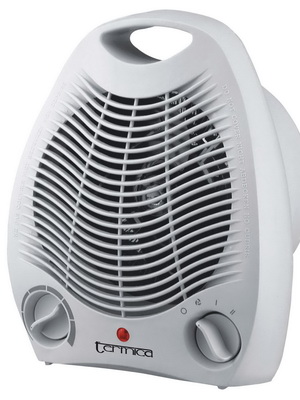
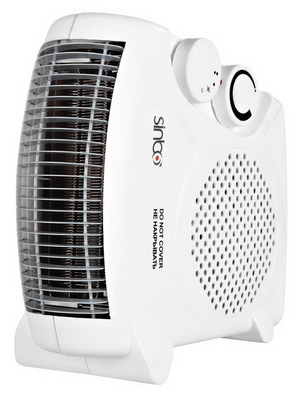
Fan heaters are the fastest and easiest way to raise the temperature in a room, especially when you arrive at a damp and cold house in early spring or late autumn and the stationary heating system is not yet turned on. The principle of operation of the device is that it accelerates the air warmed by the heating element.
All models on the market today have protection against overheating, and some can even ventilate the room without heating.
Fan heaters are divided into spiral and ceramic. Spiral models of Chinese and domestic production are usually inexpensive - from 500 rubles. They are compact, can have several heating capacities, are equipped with safety and space heating thermostats.
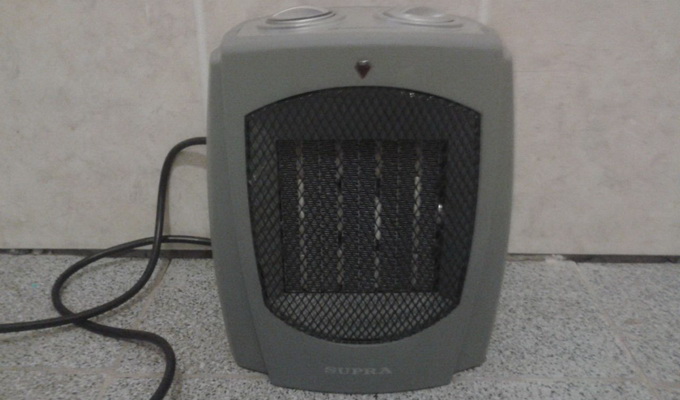
In ceramic fan heaters, a ceramic plate serves as a heating element. A device with a power of 2000 W is able to quickly warm up the air in a room of 20 m2.
In addition, it is safe: the fan can be left on for a long time and not worry about the safety of the room. But this type of heater will cost several times more than a spiral one.
All fan heaters create noise during operation. They have another drawback - they dry the air, and the higher the heat transfer, the drier the air. Therefore, if you use the heater for a long time, it would be good to keep an open container of water in the room. The larger the surface area of the water in the vessel, the better. An aquarium is perfect for this purpose.
oil heater
Such heaters can become a source of soft heat and are perfect for heating a room from 10 to 30 m2, depending on the power of the model. The temperature of the heater body does not exceed +150 °C, during operation it does not make noise, has no smell of burning and dust. The oil heater will work quietly for several days without interruption.
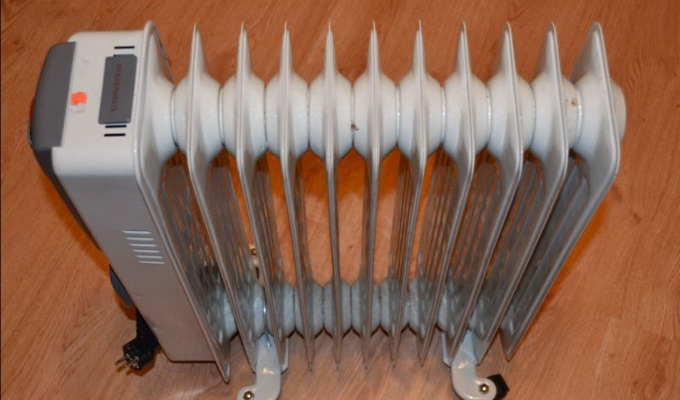

The outer case is very often made in the form of a battery (radiator), inside which there is an electric coil and mineral oil. The coil heats up the oil, which heats up the battery case from the inside. Older models of oil heaters heat the air for half an hour. Modern ones are equipped with a fan and are able to do it faster.
An oil heater can have 2-3 power levels if it is designed for 1.5 kW or more.
The built-in thermostat allows you to maintain the same temperature to the nearest degree, which saves energy. After reaching a certain temperature, the heater turns off and turns on only when the temperature has fallen below the set level. Such inclusions can be every 10-15 minutes.
To maintain a constant temperature in a small room of 10 m2, an oil heater with a power of 1 to 1.5 kW is enough. To heat a room with an area of 30 m2, you will need a device of 3 kW.
When operating an oil heater, it is important to observe the following rules. First, keep the heater upright, do not tilt or turn it over, otherwise it will burn out. Second, do not install in a room smaller than 4 m2. Third, do not use for drying clothes, do not place near the bathroom, shower or pool. Fourth, do not plug in with wet hands.
The simplest modifications of an oil heater of Chinese or domestic production can be purchased in stores at a price of 1 thousand rubles.
Heating of a private country house with electric convectors (electric convectors)
Electric convector heating can be used as the main or additional source of heat. It is able to intensively warm the air, increasing the circulation of its flows. Modern devices are safe and can be operated without constant monitoring.
Electric convectors for heating a private house consist of two vertically arranged metal panels between which air circulates. Cold air is heated by passing between the panels in the direction from the floor to the ceiling.
The heating element consists of a tubular electric heater (TENA) and aluminum radiator located between the panels at the bottom of the convector. The radiator contributes to a more efficient transfer of heat from the heating element to the air.
Heating a private house with electric convectors is divided into two types: wall-mounted and universal.

Wall-mounted ones are easy to mount: it is enough to make four holes in the wall with a drill, install self-tapping screws, hang the convector on the bracket, plug it into the socket - and the device is ready for operation.
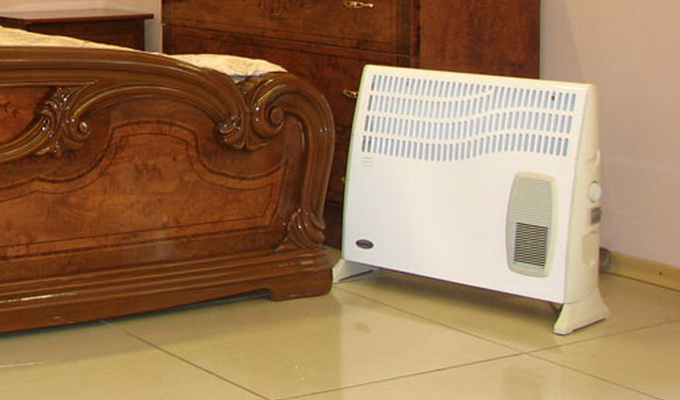
Universal electric convectors are installed both on the floor and on the wall.
The device will work without breakdowns for at least 10 years. Its effectiveness primarily depends on the quality of the heating element. Power ranges from 0.5 to 3 kW.
In order for the heating of a country house with electric convectors to be comfortable and safe, the devices are equipped with a thermostat to control the room temperature. There are models with a special coating that allows them to be used in wet rooms. Many appliances are equipped with safety sensors that turn off the heater when it overheats. Some models have a low temperature function (+5 °C), which prevents the room from freezing.

Sometimes electric convectors are used to heat the whole house, if not autonomous heating. But it is worth mentioning right away that this heating system is an expensive pleasure. We take from the calculation of the house with total area 150 m2 electricity consumption for heating 7-8 kW / h. Now we multiply the cost of 1 kW / h by 24 hours and by 30 days - we get the cost of such heating per month.
Heating with a heat gun
A powerful fan heater that can run on fuel (kerosene, diesel fuel, waste oil) or electricity. The basic principle of operation is the creation of a large air exchange, due to which the room warms up quite quickly. For heating residential premises, electric heat guns are most often used.
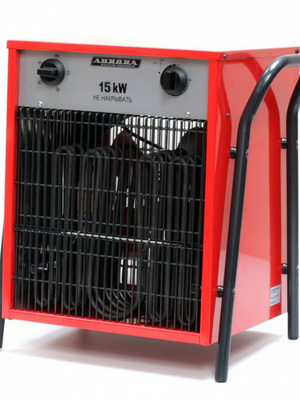
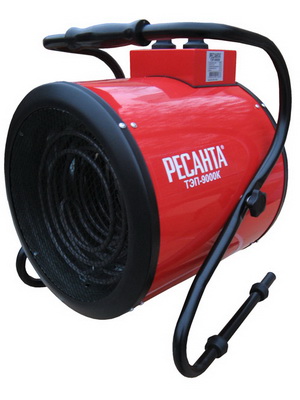
According to the design, the devices can be either rectangular or cylindrical. Rectangular heat guns have a heating element in the form of a grid. Guns with a cylindrical body have a spiral heating element that produces warmer air.
The devices are produced in different capacities, therefore, when choosing, it is necessary to proceed from the fact that 0.8-1.4 kW of power is required to heat 10 m2. If the room to be heated has an area of 20 m2, a 2 kW gun is needed.
Such a mobile air heater is perfect for drying plastered walls, temporary heating of a room or terrace.
The main disadvantage of heating with a heat gun can be called high energy consumption.

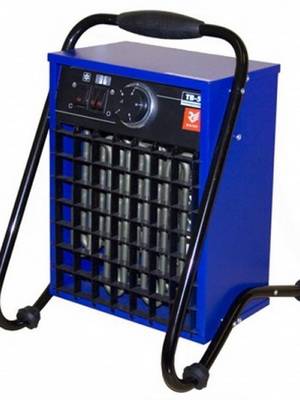
The most popular are models from domestic manufacturers of the Tropic company, foreign ones - Frico and General. Electric heat guns operating from a 220 V network cost 3-6 thousand rubles. depending on the power and brand of the manufacturer.
Home heating with infrared heaters and electric fireplaces
Unlike others heating devices These heaters do not heat the air in the room, but the objects themselves that are in it. Those, in turn, absorb heat and release it into the atmosphere. Thus, the most efficient heating of the room occurs with minimal resource consumption, the total cost of heating with infrared heaters is reduced by 5-10 times.
Speaking about the advantages of heating a house with infrared heaters, it is worth noting that only they allow you to heat a room in zones or points. Using such a device, you can reduce the overall temperature in the room by several degrees, while not reducing comfort. The heat from the heater will be absorbed and the air temperature will remain the same. Moreover, a decrease in the heating temperature by only 1 °C leads to energy savings of 5%.
When using convectors for heating, the air falls in layers, from the warmest at the top to the coldest at the bottom. An infrared heater avoids this by equalizing the heating temperature from floor to ceiling, which reduces energy costs by 10-40%.
For the home, you can choose a portable device in the form of a lamp on the rack, then you do not have to lay wires.
In addition, the infrared heater is the only device that is allowed to be used outdoors. You can safely have a picnic in October in the gazebo in the country, without fear of freezing. It will keep you warm here too.
Depending on the nature of the luminosity infrared heaters They are conditionally divided into light, the surface of which is capable of heating up to temperatures above 600 °C, and long-wavelength, which are heated up to 600 °C. Lighting devices are most often used to heat rooms where a lot of heat is required. Longwave is usually used to heat small rooms or greenhouses. It is not advisable to heat rooms with an area of more than 60 m2 in this way.

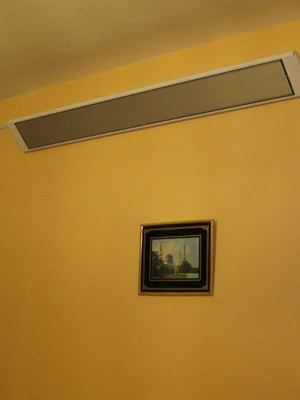
By design, they can be made in the form of a chandelier on a stand or panel.
Infrared heaters are absolutely safe for health as it is the only natural natural look heating. Such devices are ideal for local heating and outdoor areas.
Many people dream of having a real fireplace in their home, but its construction is not always possible for a number of technical reasons. A good replacement could be a copy of it that runs on electricity. This device easy to use, easy to use and able to give pleasure from admiring the fire, like a real fireplace. In addition, it allows you to control the air temperature in the house, since it is equipped with the functions of both zone heating and heating the entire area of \u200b\u200bthe room.
Thanks to two fans, air enters the fireplace, then under the action of the heating element and comes out well warmed up.
The fireplace, located in the room, is able to warm it up well, spreading heat throughout the area. In addition to heating, it also creates an imitation of a real hearth with burning flames and the sound of firewood crackling. At the same time, such a fireplace consumes no more electricity than one electric light bulb.
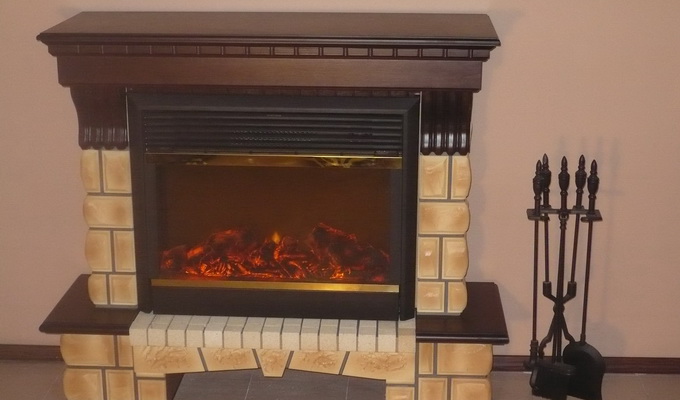
This device is an economical device that consumes 1-2 kW / h of electricity, it is easy to connect - you do not have to equip a chimney or supply gas pipes. Maintenance costs are also minimal, parts do not wear out, and cleaning is not required.
Modern electric fireplaces even have a remote control. Devices are hinged, classic, extra wide and freestanding.
From the variety of heaters, you can choose the most suitable one. But you should not be limited to heating from the device and it is better to equip the house with a full-fledged electric water heating system.
The heating system of a private country house with an electric boiler: which electric boiler to choose, and what are
Unfortunately, gas pipelines have not been built in all regions of our country. In this situation, they usually install an autonomous steam-water heating system for a private house with an electric boiler. The straight-through boiler is a cylindrical tube with a heating element inside. Which electric boiler to choose to solve your urgent tasks of providing thermal energy? To do this, you must first understand what electric boilers are and how they differ fundamentally from each other. After studying all the information provided, you can make the right decision regarding which electric boiler to choose for the house and its heating.
The heat carrier in this case is water or non-freezing liquid, the method of heating of which may be different. In some systems, a tubular electric heater with a high resistance inner conductor, the so-called boiler, is built in, which heats running water. The system starts working as soon as it is turned on.
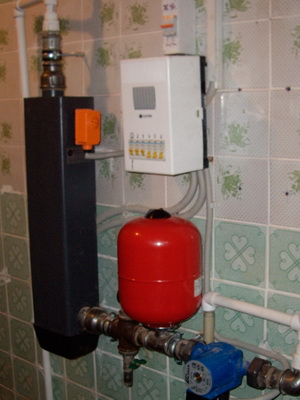
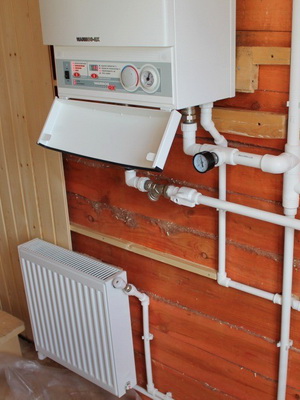
Heating a country house with an electric boiler can be used in conjunction with gas or solid fuel, including them during the day, and an electric boiler at night. Indeed, in the dark, the tariff for electricity is lower, you just need to install a two-tariff meter.

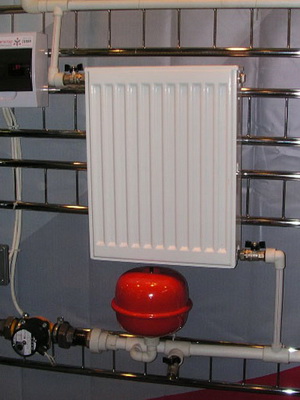
There is another type of boilers powered by electricity - electrode, or ionic. Water in such an apparatus is heated due to the fact that ions move between the electrodes. Voltage is applied to the electrodes located at a certain distance from each other and immersed in the heat-transfer fluid. There is a splitting of molecules into positively and negatively charged ions, which tend, respectively, to the positive or negative electrodes. During this process, thermal energy, which is transferred to the coolant. Thus, the water is heated.
Unlike the previous type, the electrode boiler heats up gradually. Electricity consumption will also depend on the volumes consumed, the set temperature and the total volume heating system.

The boiler has a cylindrical shape, adjusts itself to the required power consumption and can turn off if the temperature rises above the temperature set for the batteries or the air in the room. In the event of a short circuit, liquid leakage or overheating, the device switches itself off.
Depending on the power, such a boiler is able to supply coolant for 4-40 radiators in the house. Such equipment can be equipped with an automatic temperature controller and an electrical control panel. They control the room temperature and power consumption.
The power of the device is always chosen with a margin, and the power of the mains is also taken into account. If 3 kW is enough to heat the house, a 4-5 kW boiler should be chosen.
Of the imported brands of electric boilers, German Bosch, Eleko and Protherm, Polish Kospel, and Czech Dakon can be distinguished:

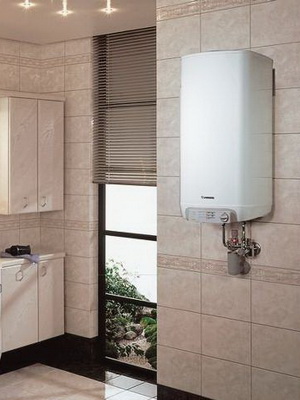

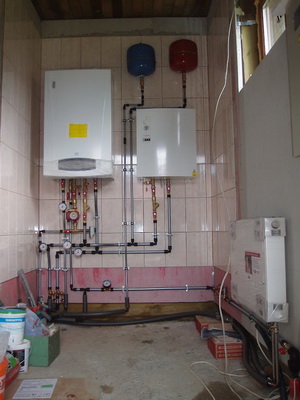
The heating system also includes a heating network, where there is a process of natural or forced (with the help of a pump) circulation of the coolant, which moves through the pipes and fills the batteries. The liquid that has given off heat to the radiators again enters the boiler, where it is heated.
It may seem that heating a house with electricity is a costly affair. However, electric heating has its advantages. As a rule, such a system is fully automated and equipped with a remote control. For the installation of an electric boiler room, a chimney and a separate room are not required. Thermostatic valves built into the heating system regulate the heating of the batteries and save energy consumption.
Thermal curtains for the home: which one to choose?
Thermal curtains for the home are designed to separate the cold and warm zones and cannot be used as the main source of heating. They are placed above the doorway or window.
The device does not allow cold air to penetrate inside, creating an invisible barrier. The main purpose of such a device is to heat places where doors often open and people constantly enter and exit.
But more and more often, thermal curtains are installed in country houses, isolating and keeping warm air from penetration of cold from the street. Heat loss in the dwelling will be minimal, regardless of whether it is heated by a fireplace, stove or gas boiler. Let's try to understand the question of which thermal curtain to choose for your home.
The thermal power of the device is from 3 to 9 kW. One curtain over the entrance opening of the room is quite enough if you insulate windows for the winter or install plastic double-glazed windows.
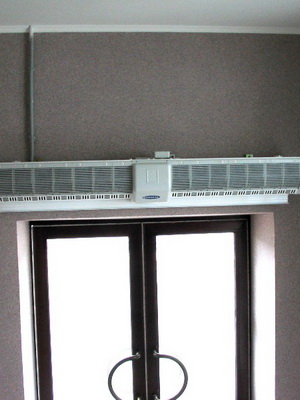

Thermal veils happen horizontal and vertical. By design features they are divided into electric, water and air without heating. The size of the heater is selected according to the length of the doorway, it should be slightly larger or equal to it. Controlling the operation of the device does not require special knowledge: it is equipped with a remote control and is easy to use.
Do-it-yourself arrangement and installation of a warm floor for heating and heating a private house
Warm floor - additional heating in the room, it can not be considered as the main source of heat. On very cold days, it is not able to fully warm the air in the room.
Such floors are water, when pipes with a heated fluid-coolant pass through the floor, and electric, when the heating cable acts as the main element of heating.
It is sometimes very difficult to make arrangement of water-based underfloor heating for heating in a private house. Its work requires a large amount of electricity to heat water, create forced circulation of the coolant. In the conditions of the Russian winter, it is difficult to organize a full-fledged heating system using only water or only electric floors.

Heating a house with underfloor heating is a design that includes a whole set of equipment: a heating section, control equipment, special parts for installation and thermal insulation.
Before you start installing a warm floor with your own hands, you should draw up a competent drawing, on which you need to mark the position of the thermostat on the wall, the location of the temperature sensor and the location of the heating cable. It is better to save the drawing in the future - it can be useful in the event of a system malfunction or when repairing an apartment.

Work on the installation of a system in which the heating of a private house is fully provided by a warm floor begins with the laying of a heat-insulating layer. Thermal insulation materials (polystyrene foam boards 5-10 cm thick) must be of high quality - this will save up to 30-40% of operating costs.

Another option for good thermal insulation is foil materials, duplicated over lavsan. They are not destroyed by the cement screed and save energy consumption by 10-20%. Material thickness - from 3 to 10 mm.
Sheets of cork or foil are also suitable as thermal insulation, on top of which a heating cable is attached with a mounting tape. Its end is connected to a thermostat. A place for the thermostat is determined on the wall, a temperature sensor is installed near it, which passes between two heating cables.
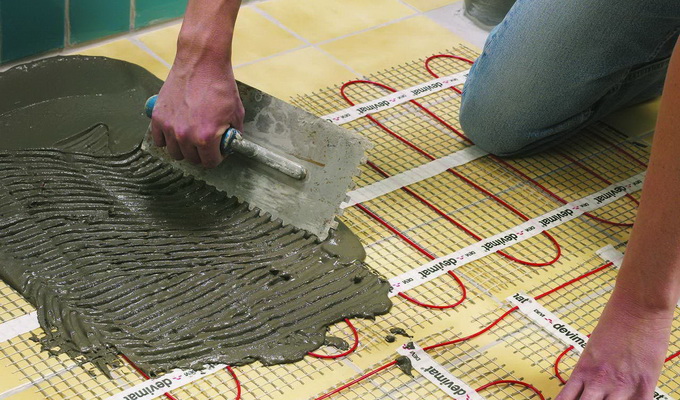
Having mounted heating system, check its integrity with a tester. Only after that, the floor screed is performed with a cement-sand mortar. It should be at least 3 cm thick, only such a layer can provide strength. Turning on the operating system is possible after 28 days, when the screed will acquire maximum mechanical strength.
![]()
A floor covering is laid on top of the screed: linoleum, carpet or tile. It is worth noting that cork or carpet, laid on top of the underfloor heating system, reduces the heat transfer of the structure. Heating the house with underfloor heating in this case can be inefficient and costly in terms of the amount of resources used.
When first turned on, the floors are heated for a whole day in order to finally dry the bulk layer.
Compared to using a heater, underfloor heating is considered cost-effective. The energy consumption of the system is 25% of the power of the heating cable, while it is capable of providing heating from +25 to +40 °C.
Installation of a warm floor, where a heating cable is used, is best left to specialists. Little-known nuances may arise in the work that will confuse the beginner: the complex configuration of the room, the inability to raise the floor level with a screed, etc.
A happy owner of suburban real estate, whether it is a cottage or a modest country house, always thinks about heating his home. There are many options to choose from. Unfortunately, due to objective reasons, not all of them can be implemented. Among the most acceptable is electric heating: in a private house, it is quite possible to equip such a system on your own.
The concept of "heating with electricity" is very broad. Under it are two completely different ways of organizing space heating:
- With intermediate coolant. It assumes the presence of a system with a circulating coolant, which heats up the boiler, powered by electricity.
- With direct heat dissipation. Various equipment is used that directly converts electrical energy into thermal energy. These can be various convectors, heaters, fan heaters, etc.
Is it profitable to heat with electricity?
It must be admitted that heating a country house with electricity has many advantages:
- High efficiency and durability.
- Ease of installation of devices.
- Ease of use, no need for regular maintenance.
- System security.
- Silent and clean operation of devices, easy replacement of equipment elements.
- Permissive documentation for the installation of the system is not required.
One of the main disadvantages is considered to be the relatively high cost of electricity. However, it is quite possible to organize economical heating with electricity if you install thermostats that will turn off the system when a predetermined air temperature is reached. You can also use a multi-tariff meter, which will allow you to pay for energy consumed at night, when the temperature is much lower and enhanced heating is required, at a special, lower tariff. Another way to pay less for electricity is to thoroughly insulate your home.
The only obstacle to installation heating equipment powered by electricity becomes insufficient power line. Preliminary calculations can be carried out as follows. On average, for heating an area of 10 square meters. meters of a building with standard thermal efficiency takes 1 kW per hour. Thus, the electric heating of a house with an area of 150 square meters. m will require 150 kW. For some legacy power lines, this may be too much. In addition, it should be borne in mind that in addition to heating, various household appliances also work in the house, which also consume a certain amount of power. Therefore, you need to add another 3-5 kW per hour to the resulting calculated power.
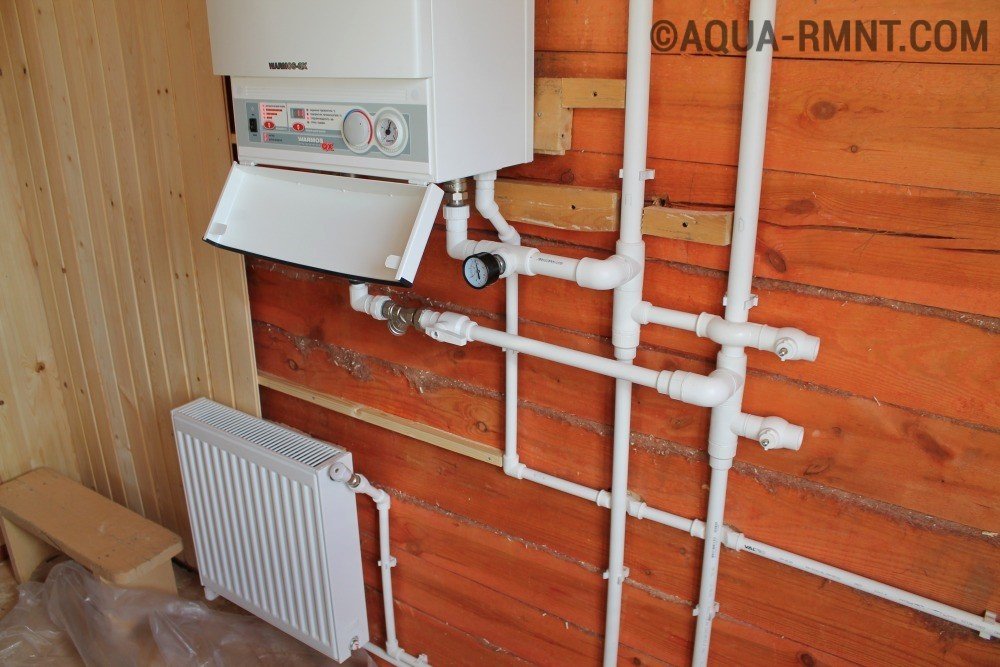
The electric boiler is included in the standard water heating system, it successfully heats the coolant
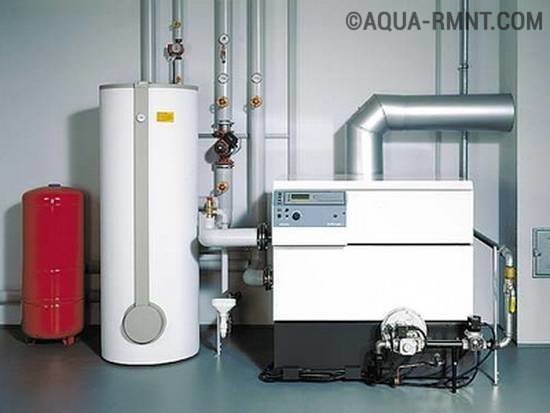
The electric boiler is quite simple to install and does not require permits
The device of the convector system
One of the popular ways to equip the heating of a private house with electricity can be considered the use of convectors, devices that use air convection in their work.
The device and principle of operation of the convector
In a metal case heater built-in thermostatically controlled heating elements heating elements. Each of them is a high-resistance conductor placed in a ceramic sheath, hermetically sealed in an aluminum or steel case. This design of the device allows you to increase the area of interaction with air and effectively heat it. The operating temperature of the heating elements varies from 100 to 60C.

Convectors are dependent on the supply of electricity, which makes their owners think about the availability alternative heating system in case of an accident
After turning on the convector, heating of the heating elements begins. According to physical laws, the cooled air goes down. Here it enters the structure through the lower grate and passes through the heating elements, gradually warming up and rising up. There it gradually cools down and sinks down again. The process is repeated many times, allowing you to create a comfortable temperature in the room. If necessary, fans can be used to speed up natural convection.
The design features of convectors determine their main disadvantages, including uneven heating of the air. The temperature at the floor itself remains lower than under the ceiling, which, however, is also characteristic of water heating. Another “minus” is that circulating flows raise dust, which is inevitably present in every home. Today, models are produced that are practically devoid of this drawback.
Wall or floor version?
Heating can be carried out using different models of convectors. There are two main types of devices:
- Wall structures. They differ in height, which averages 45 cm, and in the method of attachment. They can either be installed directly on the floor or fixed to the wall using a special device.
- Floor. Narrow long appliances, which are usually installed under low-lying windows, stained-glass windows and around baseboards. Despite the lower power than wall convectors, they will need much less time to heat up the room.
Both types of devices are equipped with thermostats, which can be either built-in or remote. Designs are also produced that do not burn oxygen in the room and do not dry out the air.

The wall model of the convector is mounted on the wall using special fasteners
